

Manila is a city that never sits still: part chaos, part charm, and entirely alive. One moment you’re sipping coffee in a sky-high café in BGC, the next you’re weaving through jeepneys and street vendors selling taho and pandesal.
For expats, freelancers, and remote workers, Manila offers the best of both worlds: the energy of a big city and the warmth of a tight-knit community. The cost of living depends on how you want to experience it. You can choose a budget-friendly apartment in Quezon City, a sleek condo in Makati, or a luxury flat overlooking the Manila Bay sunset.
Read also: The best digital nomad jobs in the Philippines
Finding a place to live in Manila means balancing convenience, comfort, and chaos — in the best way. The city is a mix of buzzing business districts, laid-back residential areas, and emerging suburbs that suit every lifestyle and budget.
Rents vary depending on the neighbourhood, proximity to business hubs like Makati or BGC, and whether your apartment is furnished or includes utilities. Modern condos tend to cost more, but they come with great amenities like pools, gyms, and 24-hour security.
The beating heart of Manila’s expat life. Makati and BGC are sleek, walkable, and filled with cafés, coworking spaces, and high-end malls. They’re the go-to choice for professionals and freelancers who want convenience, safety, and a social scene right outside their door.

Centrally located and more budget-friendly than Makati or BGC, these areas offer excellent value and easy access to the rest of Metro Manila. Perfect for professionals who want city living without the top-tier price tag.
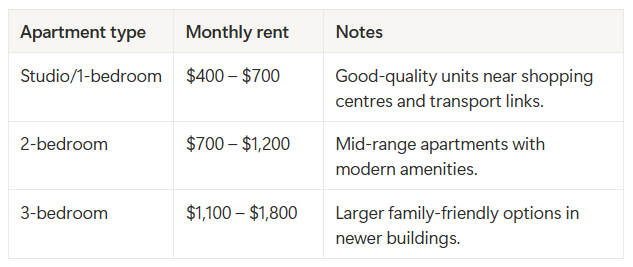
One of Manila’s largest and most diverse districts, Quezon City combines residential charm with a lively food and entertainment scene. It’s home to universities, media companies, and a thriving student community.
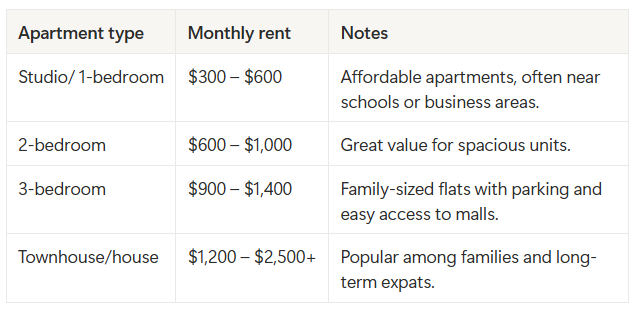
These areas are ideal for families or anyone seeking more space and a quieter environment. You’ll find modern gated communities, good schools, and lower rents than in the city centre — but expect longer commutes.
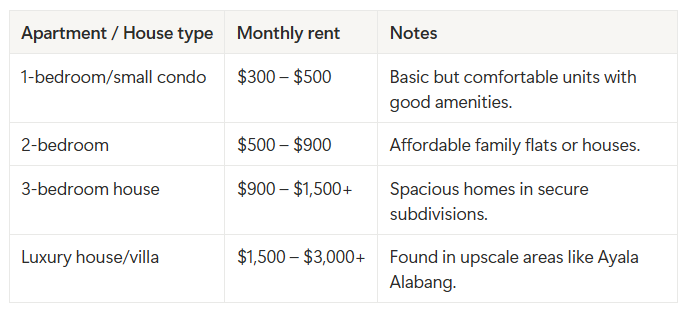
Manila moves fast (and sometimes not at all). Between its endless traffic jams and new transport options, getting around the city can be an adventure in itself. Expats and locals alike mix and match taxis, ride-hailing apps, jeepneys, and trains to balance comfort, time, and cost.
Taxis
Taxis are everywhere in Manila and remain one of the easiest ways to get around. They’re metered and affordable, though rush-hour traffic can make short trips take forever. Always opt for reputable companies or use an app to book.
Ride-hailing apps (Grab, JoyRide)
Ride-hailing apps dominate Manila’s transport scene, especially for expats and professionals. Grab is the most popular and reliable, offering both cars and motorbike rides. It’s safer, air-conditioned, and cashless.
Jeepneys
A true icon of Filipino culture. Jeepneys are colourful, shared minibuses that follow fixed routes across the city. They’re cheap and everywhere, but not ideal for those unfamiliar with routes or the language.
Buses
City buses run along major roads like EDSA and offer an affordable way to travel between business districts. Modern point-to-point (P2P) buses are air-conditioned and comfortable — a good choice for longer commutes.
Metro and trains (LRT, MRT, PNR)
Manila’s train network is limited but handy for avoiding traffic during rush hour. It covers key parts of the city, though carriages can get crowded.
Motorbikes and scooters
Motorbike taxis are gaining popularity, especially with apps like Angkas and JoyRide. They’re fast, convenient, and can weave through traffic — a lifesaver for short trips.
Car rentals / driving
Driving in Manila gives freedom but comes with challenges — traffic, parking, and local driving habits. It’s best suited for longer stays or weekend trips.
Walking and cycling
Walking is common within gated communities or business districts like BGC and Makati, but less practical citywide due to heat and traffic. Cycling is slowly growing in popularity thanks to new bike lanes.
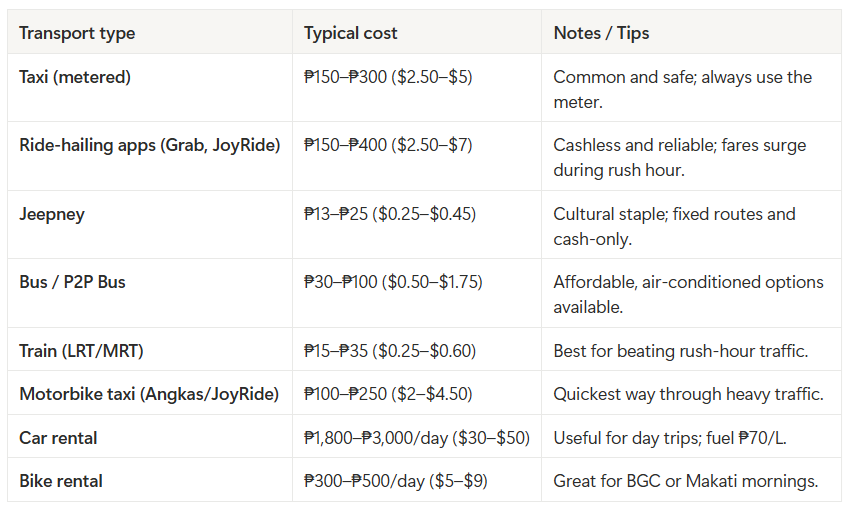
Manila is a food lover’s playground, from street eats to hip cafés and international dining spots. The city’s food scene blends Filipino comfort dishes with flavours from all over Asia and the West, making it easy (and tempting) to eat out often.
Restaurants
Eating out in Manila can fit any budget. You can grab a hearty local meal for the price of a coffee abroad, or splurge on fine dining in Makati or Bonifacio Global City (BGC).
Cafés are everywhere — perfect for remote work or lazy brunches. A latte and pastry typically cost ₱250–₱400 ($4–$7).
Supermarkets and markets
Grocery prices in Manila vary depending on where you shop. Local palengkes (wet markets) are the cheapest for fresh produce, while supermarkets like SM or Robinsons offer convenience and imported goods at higher prices.
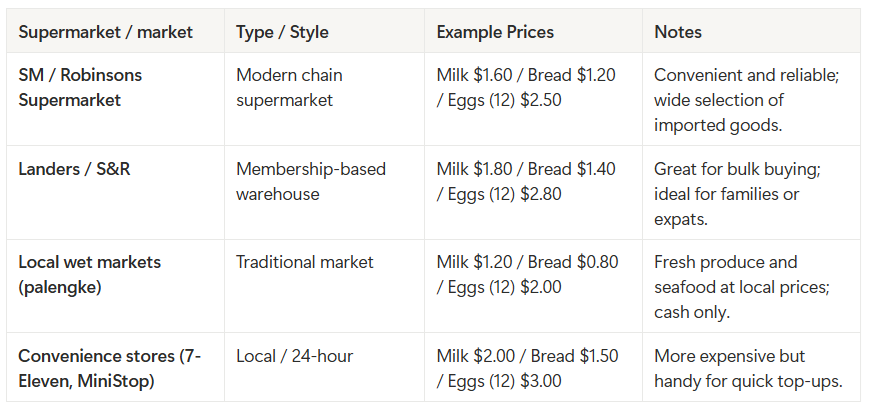
Many expats buy local fruits, vegetables, and meat at wet markets, then stock up on snacks and international items at big supermarkets or membership stores. Imported food, dairy, and wine tend to be pricier than local options.
Here’s a realistic monthly breakdown in USD:
For one person
Total monthly food budget: $400–640
Enough to cook most meals at home, eat out a few times a week, and still enjoy Manila’s endless dining options.
For a couple or small family
Total monthly food budget: $800–1,200
That’s enough for a comfortable mix of home cooking, restaurant dining, and weekend brunches around Makati, BGC, or Ortigas.
Manila’s utility costs are moderate by Southeast Asian standards but can fluctuate depending on your location, lifestyle, and building type. Air conditioning, in particular, can raise your bills significantly during the hot and humid months.
Electricity
Electricity is one of the biggest household expenses in Manila. Air conditioning, refrigerators, and water heaters drive up costs, especially during the dry season (March–May).
Water
Water is relatively affordable in Manila and supplied mainly by Manila Water or Maynilad, depending on your area. Many condos include water in the rent, but houses or older buildings may bill it separately.
Gas
Most homes use LPG (liquefied petroleum gas) for cooking. Gas tanks are easy to order and delivered directly to your home.
Internet
Manila has wide internet coverage, though connection speeds can vary. Fibre is now common in most urban areas and is the best choice for remote workers or streaming-heavy households.
Mobile / Cell phone
Mobile plans are affordable and widely available. Most expats use prepaid SIM cards, which can be topped up online or at convenience stores.

Manila has a well-developed healthcare system that combines affordable public services with excellent private hospitals that cater to both locals and expats. While the public system offers accessible care, most foreigners and professionals rely on private facilities for faster service, modern equipment, and English-speaking staff.
Public healthcare
The Philippines’ public healthcare system is overseen by the Department of Health (DOH) and supported by PhilHealth, a national insurance programme that helps subsidise hospital and medical expenses. Public hospitals can be very affordable but are often crowded and have longer waiting times.
Public healthcare is useful for emergencies or basic treatments, but expats typically prefer private hospitals, which offer more comfort, shorter waits, and international standards of care.
Private healthcare and insurance
Private healthcare in Manila is modern, efficient, and relatively affordable compared to Western countries. Leading private hospitals such as St. Luke’s Medical Center (BGC and Quezon City), Makati Medical Center, and Asian Hospital are well known for their world-class facilities, international accreditation, and English-speaking doctors.
Health insurance is highly recommended for expats and long-term residents. Both local and international providers offer a range of plans suitable for different budgets and coverage levels. Popular insurers include AXA Philippines, Allianz PNB Life, Cigna Global, and Pacific Cross.

Tip: Many expats choose to pay out of pocket for minor visits since private consultations are affordable. Pharmacies are easy to find across the city and well stocked — most common medications are available without a prescription.
Manila offers a mix of modern city living and laid-back tropical charm, with a cost of living that’s lower than most Western or Gulf cities. From bustling business districts to leafy neighbourhoods and beach getaways just a drive away, the city suits a wide range of lifestyles and budgets.

You can live comfortably in Manila for around $1,200–1,800 per month, depending on your area and lifestyle. Costs rise if you prefer imported goods or high-end accommodation, but local options make it easy to live well on a reasonable budget.
Manila is one of those cities that never misses a beat, lively, unpredictable, and full of opportunities at every corner. Between rent, food, and daily adventures, managing your finances wisely can make all the difference.
With Grey, you can receive international payments in USD, GBP, or EUR, convert when rates are best, and withdraw PHP directly to a Philippine bank account. It’s fast, secure, and built for global citizens who call multiple places home.
Open a free Grey account to make life in Manila smoother and stress-free.




.svg)
Back to top